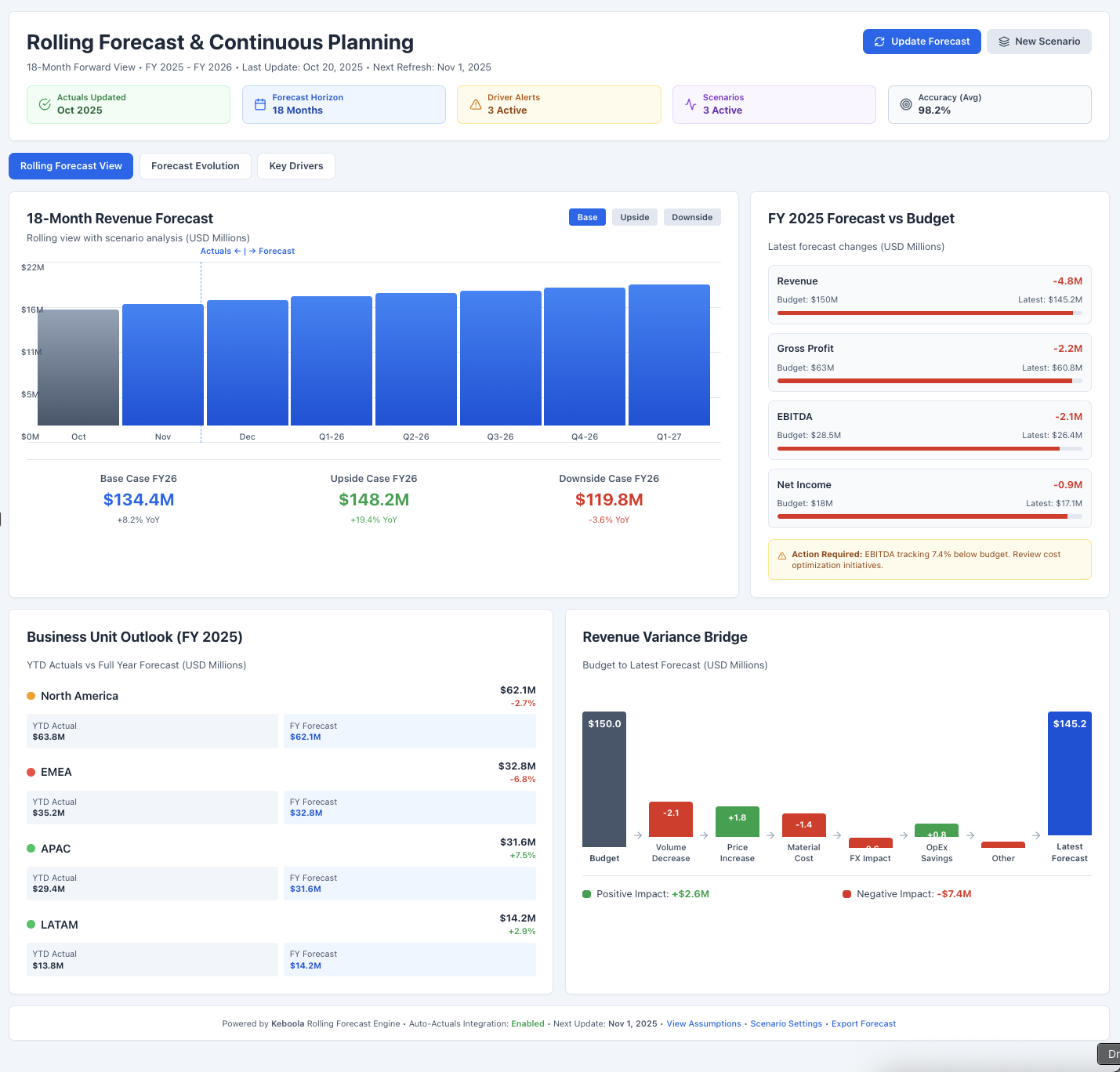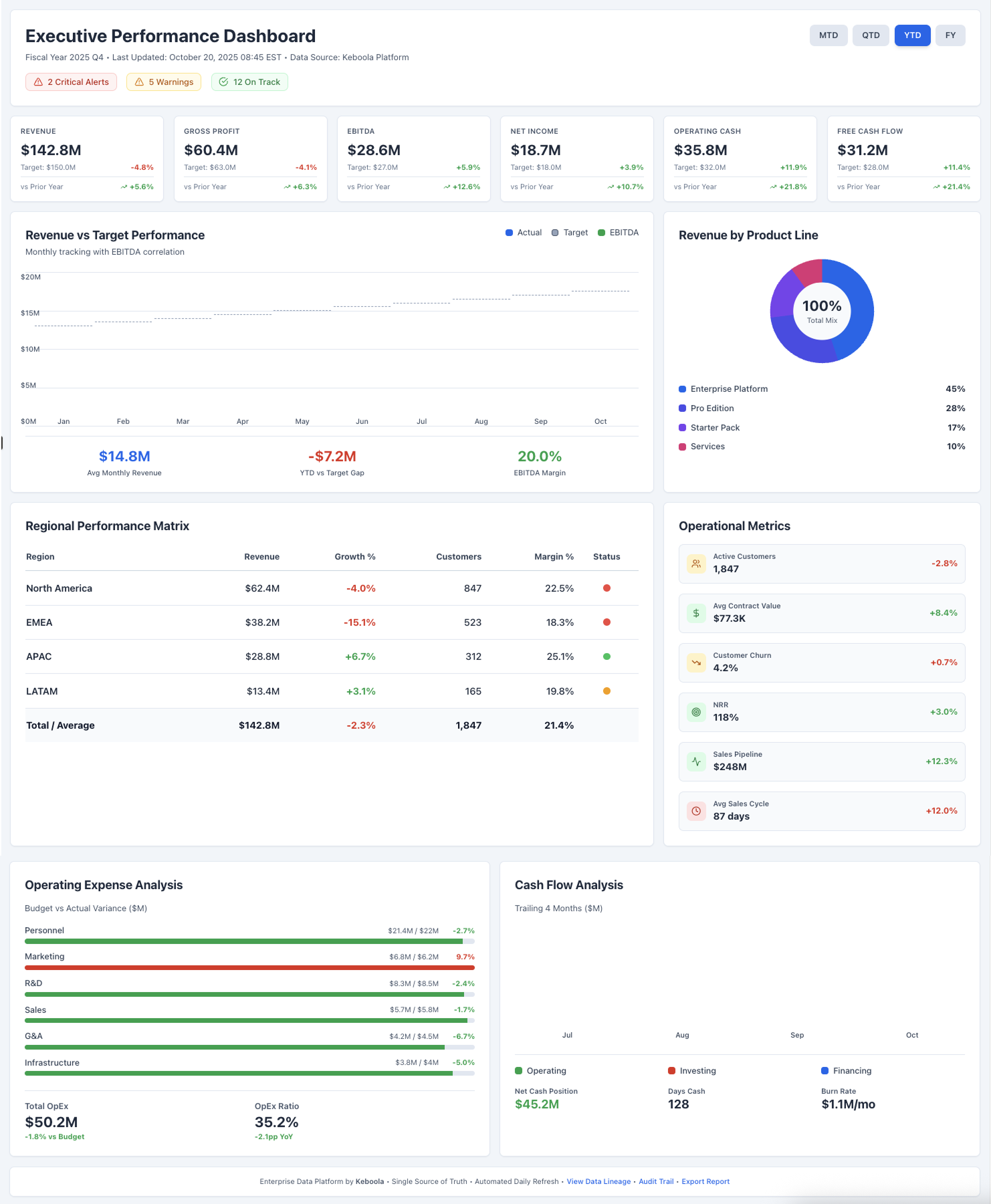Run your data operations on a single, unified platform.
- Easy setup, no data storage required
- Free forever for core features
- Simple expansion with additional credits

Thank you! Your submission has been received!
Oops! Something went wrong while submitting the form.

Request a Demo
Working Capital Optimization Analytics
Uncover opportunities in receivables, payables, and inventory to free up cash and reduce costs.

Dashboard shown is a conceptual example. Keboola integrates with any BI or analytics platform.


Overview
This use case provides deep analytics on the components of working capital – accounts receivable, accounts payable, and inventory – to help finance teams and CFOs optimize the company's cash conversion cycle. It brings together data from sales, procurement, and operations into a finance-centric view, highlighting where cash is tied up unnecessarily. For instance, it can identify customers who are consistently late in payments, suppliers where early payment discounts can be leveraged, or slow-moving inventory that could be liquidated. In complex industries like manufacturing or retail with many SKUs and long supply chains, this is invaluable. The output guides decisions such as adjusting credit terms, improving collection processes, or changing inventory reorder strategies. A finance professional who has spent too many days calculating DSO and DPO in spreadsheets will appreciate the automated, continuous insight this provides to drive strategic working capital improvements.
Your Challenges

Hidden Cash Drains
Without proper analysis, companies often have cash traps – e.g., overly liberal customer payment terms or inefficient inventory levels – that go unnoticed.

Siloed Metrics (AR, AP, Inventory not linked)
Working capital elements are usually managed by different teams (sales/AR, procurement/AP, supply chain/inventory).

Delayed Insights
If finance only reviews working capital metrics monthly or quarterly (often with significant lag in data consolidation), they miss timely opportunities.

Excess Financing Costs
Inefficient working capital means the company might be borrowing more on credit lines or holding less cash reserves, incurring interest costs or liquidity risk


Our Solution & Value

End-to-End Cash Conversion Cycle View
xKeboola brings receivables, payables, and inventory data into one model, allowing calculation of DSO (Days Sales Outstanding), DPO (Days Payables Outstanding), and DIO (Days Inventory On-hand) consistently across the enterprise.

Granular Drill-Downs
Unlike static reports, the platform lets you drill into specific segments – e.g., DSO by customer, by region, by product line – to pinpoint issues or best practices.

What-If Scenario Analysis for Cash Impact
The analytics aren't just backward-looking; they allow finance teams to simulate improvements. For instance, "What if we reduced average inventory by 10 days? How much cash is freed up?"

Continuous Monitoring & Alerts
With Keboola, working capital becomes a continuous KPI, not a periodic afterthought. Dashboards can be live, and alerts set up.
What systems can you connect?
Example Outputs
[stakeholder] CFO
- Dashboard of key working capital ratios (DSO, DPO, DIO, and overall cash conversion cycle trend), Cash release potential (in )iftargetsaremet(e.g.,") if targets are met (e.g., " )iftargetsaremet(e.g.,"X million could be freed if DSO improved to 45 days"), Peer benchmark comparison on working capital days (if data available or input manually).
[stakeholder] Credit & Collections Manager
- Accounts Receivable aging report with risk scoring, List of top 20 delinquent accounts with amount overdue and days past due, Average days late by customer segment, Effectiveness of collections (e.g., collection calls vs. payments received timing), Suggested actions (e.g., "Consider tightening credit terms for Customer A – consistently 30+ days late")
[stakeholder] Procurement/Purchase Ledger Manager
- Accounts Payable aging and schedule of upcoming payments, Current DPO vs. negotiated terms (identifying if you're paying some vendors faster than terms – an opportunity to hold cash longer), Early payment discount tracker (how often discounts are taken vs missed), Supplier segmentation showing who might offer better terms if volume increases, Inventory categorization (for inventory managers): ABC analysis indicating which stock to focus on to reduce inventory days. (While inventory manager isn't in finance, finance can share this insight with operations.)
FAQs
Our data is in different systems (ERP, warehouse, etc.) – can Keboola integrate all that for these metrics?
Yes. Keboola is built for integrating multiple data sources. It can pull AR and AP data from your ERP, and inventory data from an ERP or a warehouse management system or even Excel sheets that some teams maintain. The platform will consolidate and transform this data into a coherent schema. Even if different business units use different systems (say SAP in one, Oracle in another, a custom system in a third), Keboola can map and merge the data. The goal is a unified data model for working capital that spans your entire enterprise, regardless of source system diversity.
How do we ensure the insights lead to action (since working capital involves other departments)?
The analytics can be easily shared and even embedded into other tools. Many clients create user-specific dashboards – for example, a sales manager might get a mini-dashboard of their region's DSO and top overdue accounts, fostering accountability outside finance. Keboola's strength in governance ensures that these distributed insights are all drawing from the same reliable data. Additionally, by quantifying the impact in monetary terms, it's easier to get buy-in – e.g., showing Ops that reducing inventory by X days frees Y cash gets everyone aligned on the tangible benefit. Essentially, Keboola provides the single source of truth and an easy way to tailor the visibility of metrics to each stakeholder, driving cross-functional action.
Can the platform handle seasonality or industry-specific metrics (like working capital adjustments for certain industries)?
Absolutely. You can incorporate seasonality into the analytics model. For instance, retail clients often set different target inventory days for peak season vs off-season; Keboola's model can account for that (it can compare against seasonal benchmarks rather than a flat target). Industry-specific needs – like factoring in consignment stock or understanding customer advance payments – can be modeled as well. The platform is not a one-size-fits-all black box; you can define custom metrics or logic. If your industry tracks, say, "forward-looking DSO" based on scheduled orders, or "cash gap" in projects, those can be added. Keboola's flexibility means the working capital model adapts to your business rules, ensuring relevance no matter the industry nuances.
Related Use Cases
AI tools fail when they don’t connect to your real data or respect production workflows.





























